High-Performance Working Practices and Organisational Performance
VerifiedAdded on 2023/06/13
|16
|5299
|226
Report
AI Summary
This report provides an in-depth analysis of high-performance working (HPW) and its contribution to creating and sustaining a high-performance work organization (HPWO). It explores the concept and components of HPW, evaluating its link to sustained organizational performance, employee well-being, and competitive advantage, while also identifying barriers to its implementation. The report further examines the contribution of performance management to high levels of performance, highlighting the role of line managers and the importance of a well-structured performance management cycle. Finally, it discusses how organizations can create and sustain a community of practice to build a high-performance culture, emphasizing the significance of addressing issues like trust, conflict resolution, and leadership to ensure long-term organizational health and employee satisfaction. The report concludes by reinforcing the importance of these practices for overall organizational success.
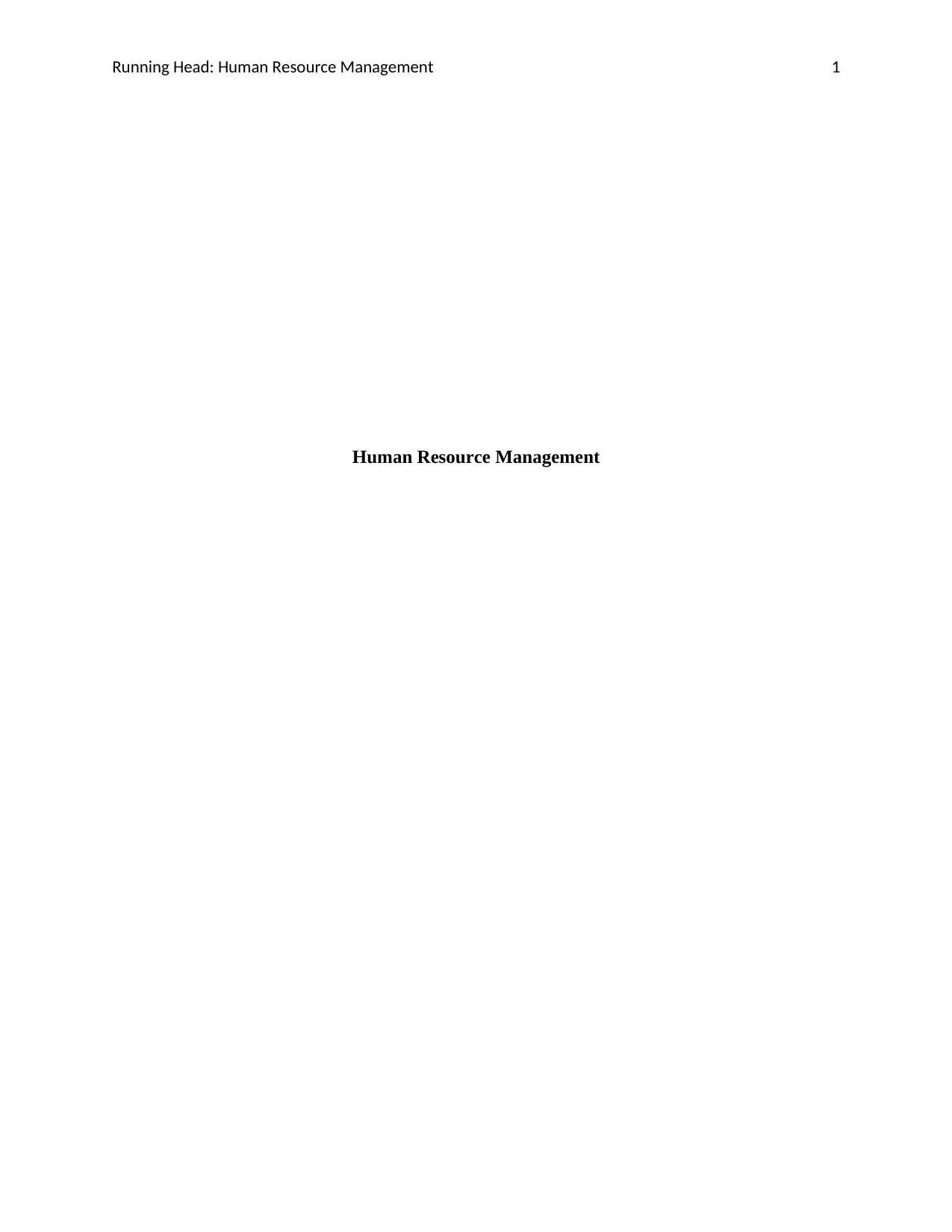
Running Head: Human Resource Management 1
Human Resource Management
Human Resource Management
Paraphrase This Document
Need a fresh take? Get an instant paraphrase of this document with our AI Paraphraser
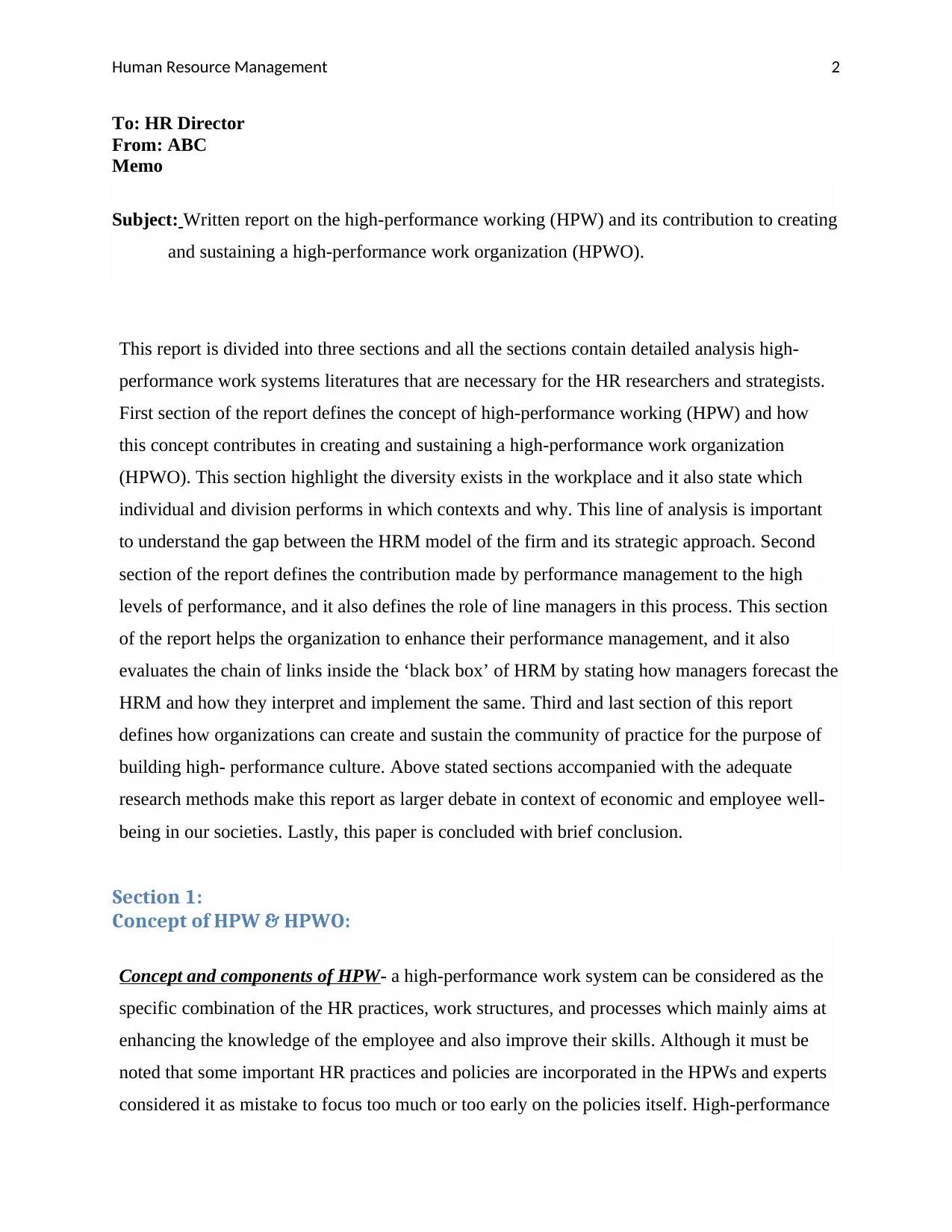
Human Resource Management 2
To: HR Director
From: ABC
Memo
Subject: Written report on the high-performance working (HPW) and its contribution to creating
and sustaining a high-performance work organization (HPWO).
This report is divided into three sections and all the sections contain detailed analysis high-
performance work systems literatures that are necessary for the HR researchers and strategists.
First section of the report defines the concept of high-performance working (HPW) and how
this concept contributes in creating and sustaining a high-performance work organization
(HPWO). This section highlight the diversity exists in the workplace and it also state which
individual and division performs in which contexts and why. This line of analysis is important
to understand the gap between the HRM model of the firm and its strategic approach. Second
section of the report defines the contribution made by performance management to the high
levels of performance, and it also defines the role of line managers in this process. This section
of the report helps the organization to enhance their performance management, and it also
evaluates the chain of links inside the ‘black box’ of HRM by stating how managers forecast the
HRM and how they interpret and implement the same. Third and last section of this report
defines how organizations can create and sustain the community of practice for the purpose of
building high- performance culture. Above stated sections accompanied with the adequate
research methods make this report as larger debate in context of economic and employee well-
being in our societies. Lastly, this paper is concluded with brief conclusion.
Section 1:
Concept of HPW & HPWO:
Concept and components of HPW- a high-performance work system can be considered as the
specific combination of the HR practices, work structures, and processes which mainly aims at
enhancing the knowledge of the employee and also improve their skills. Although it must be
noted that some important HR practices and policies are incorporated in the HPWs and experts
considered it as mistake to focus too much or too early on the policies itself. High-performance
To: HR Director
From: ABC
Memo
Subject: Written report on the high-performance working (HPW) and its contribution to creating
and sustaining a high-performance work organization (HPWO).
This report is divided into three sections and all the sections contain detailed analysis high-
performance work systems literatures that are necessary for the HR researchers and strategists.
First section of the report defines the concept of high-performance working (HPW) and how
this concept contributes in creating and sustaining a high-performance work organization
(HPWO). This section highlight the diversity exists in the workplace and it also state which
individual and division performs in which contexts and why. This line of analysis is important
to understand the gap between the HRM model of the firm and its strategic approach. Second
section of the report defines the contribution made by performance management to the high
levels of performance, and it also defines the role of line managers in this process. This section
of the report helps the organization to enhance their performance management, and it also
evaluates the chain of links inside the ‘black box’ of HRM by stating how managers forecast the
HRM and how they interpret and implement the same. Third and last section of this report
defines how organizations can create and sustain the community of practice for the purpose of
building high- performance culture. Above stated sections accompanied with the adequate
research methods make this report as larger debate in context of economic and employee well-
being in our societies. Lastly, this paper is concluded with brief conclusion.
Section 1:
Concept of HPW & HPWO:
Concept and components of HPW- a high-performance work system can be considered as the
specific combination of the HR practices, work structures, and processes which mainly aims at
enhancing the knowledge of the employee and also improve their skills. Although it must be
noted that some important HR practices and policies are incorporated in the HPWs and experts
considered it as mistake to focus too much or too early on the policies itself. High-performance
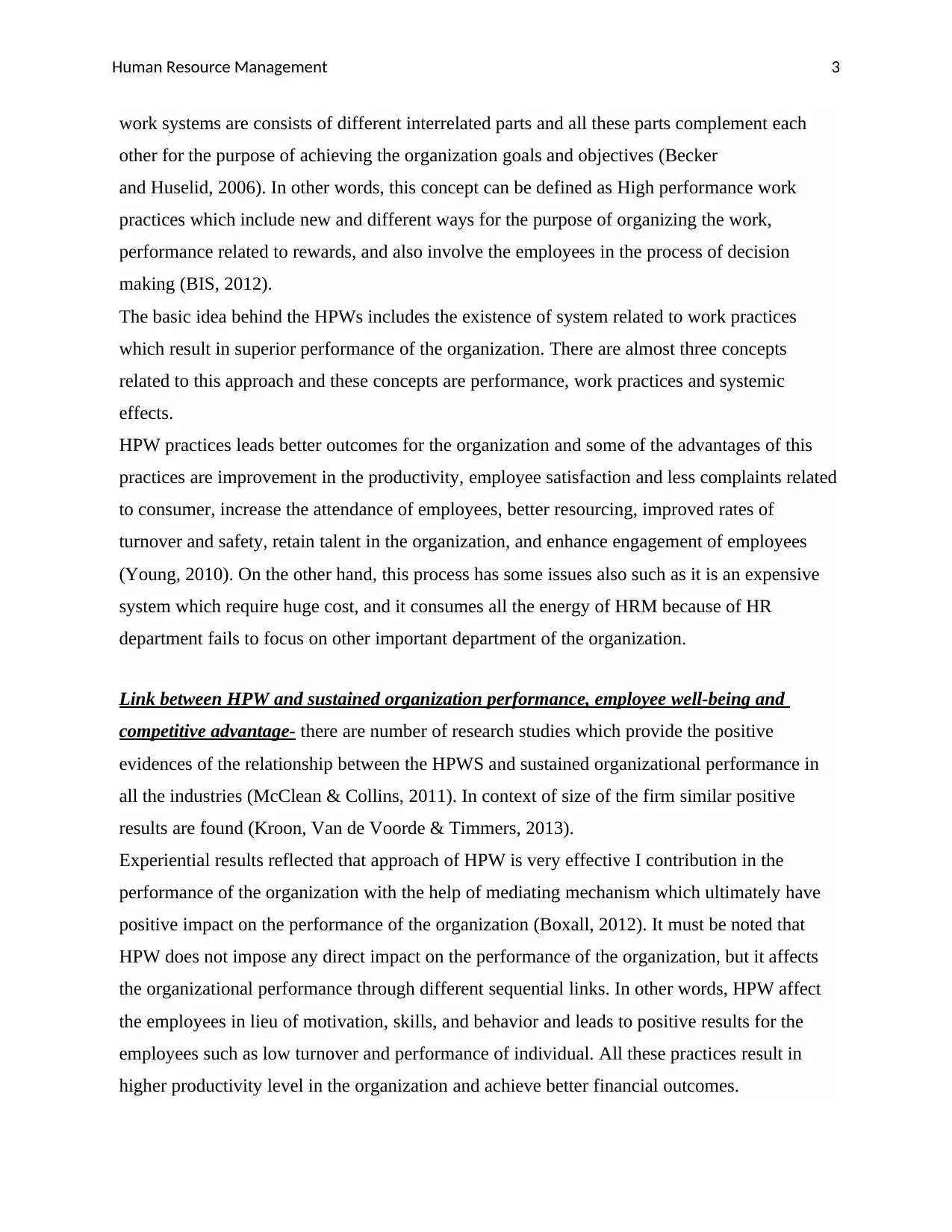
Human Resource Management 3
work systems are consists of different interrelated parts and all these parts complement each
other for the purpose of achieving the organization goals and objectives (Becker
and Huselid, 2006). In other words, this concept can be defined as High performance work
practices which include new and different ways for the purpose of organizing the work,
performance related to rewards, and also involve the employees in the process of decision
making (BIS, 2012).
The basic idea behind the HPWs includes the existence of system related to work practices
which result in superior performance of the organization. There are almost three concepts
related to this approach and these concepts are performance, work practices and systemic
effects.
HPW practices leads better outcomes for the organization and some of the advantages of this
practices are improvement in the productivity, employee satisfaction and less complaints related
to consumer, increase the attendance of employees, better resourcing, improved rates of
turnover and safety, retain talent in the organization, and enhance engagement of employees
(Young, 2010). On the other hand, this process has some issues also such as it is an expensive
system which require huge cost, and it consumes all the energy of HRM because of HR
department fails to focus on other important department of the organization.
Link between HPW and sustained organization performance, employee well-being and
competitive advantage- there are number of research studies which provide the positive
evidences of the relationship between the HPWS and sustained organizational performance in
all the industries (McClean & Collins, 2011). In context of size of the firm similar positive
results are found (Kroon, Van de Voorde & Timmers, 2013).
Experiential results reflected that approach of HPW is very effective I contribution in the
performance of the organization with the help of mediating mechanism which ultimately have
positive impact on the performance of the organization (Boxall, 2012). It must be noted that
HPW does not impose any direct impact on the performance of the organization, but it affects
the organizational performance through different sequential links. In other words, HPW affect
the employees in lieu of motivation, skills, and behavior and leads to positive results for the
employees such as low turnover and performance of individual. All these practices result in
higher productivity level in the organization and achieve better financial outcomes.
work systems are consists of different interrelated parts and all these parts complement each
other for the purpose of achieving the organization goals and objectives (Becker
and Huselid, 2006). In other words, this concept can be defined as High performance work
practices which include new and different ways for the purpose of organizing the work,
performance related to rewards, and also involve the employees in the process of decision
making (BIS, 2012).
The basic idea behind the HPWs includes the existence of system related to work practices
which result in superior performance of the organization. There are almost three concepts
related to this approach and these concepts are performance, work practices and systemic
effects.
HPW practices leads better outcomes for the organization and some of the advantages of this
practices are improvement in the productivity, employee satisfaction and less complaints related
to consumer, increase the attendance of employees, better resourcing, improved rates of
turnover and safety, retain talent in the organization, and enhance engagement of employees
(Young, 2010). On the other hand, this process has some issues also such as it is an expensive
system which require huge cost, and it consumes all the energy of HRM because of HR
department fails to focus on other important department of the organization.
Link between HPW and sustained organization performance, employee well-being and
competitive advantage- there are number of research studies which provide the positive
evidences of the relationship between the HPWS and sustained organizational performance in
all the industries (McClean & Collins, 2011). In context of size of the firm similar positive
results are found (Kroon, Van de Voorde & Timmers, 2013).
Experiential results reflected that approach of HPW is very effective I contribution in the
performance of the organization with the help of mediating mechanism which ultimately have
positive impact on the performance of the organization (Boxall, 2012). It must be noted that
HPW does not impose any direct impact on the performance of the organization, but it affects
the organizational performance through different sequential links. In other words, HPW affect
the employees in lieu of motivation, skills, and behavior and leads to positive results for the
employees such as low turnover and performance of individual. All these practices result in
higher productivity level in the organization and achieve better financial outcomes.
⊘ This is a preview!⊘
Do you want full access?
Subscribe today to unlock all pages.

Trusted by 1+ million students worldwide
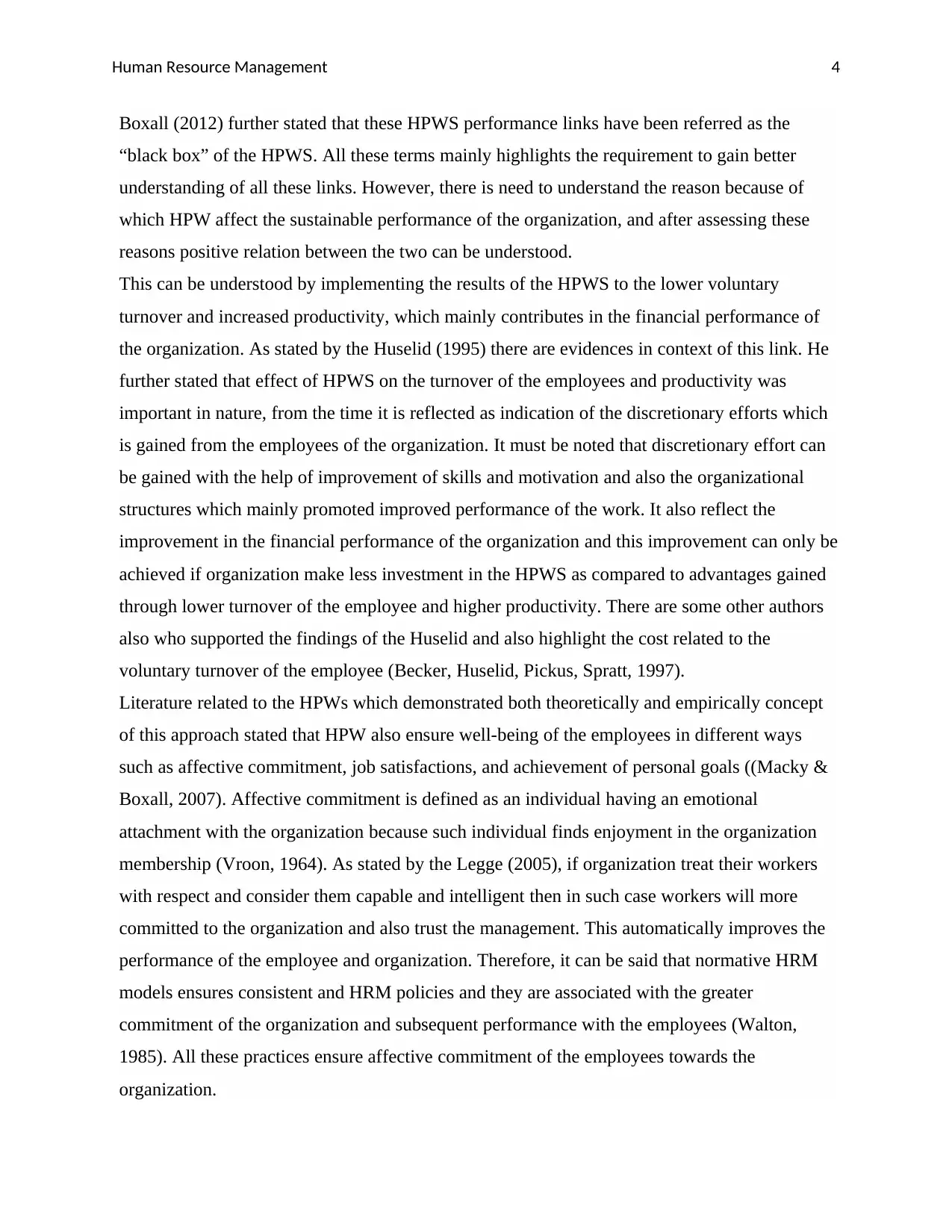
Human Resource Management 4
Boxall (2012) further stated that these HPWS performance links have been referred as the
“black box” of the HPWS. All these terms mainly highlights the requirement to gain better
understanding of all these links. However, there is need to understand the reason because of
which HPW affect the sustainable performance of the organization, and after assessing these
reasons positive relation between the two can be understood.
This can be understood by implementing the results of the HPWS to the lower voluntary
turnover and increased productivity, which mainly contributes in the financial performance of
the organization. As stated by the Huselid (1995) there are evidences in context of this link. He
further stated that effect of HPWS on the turnover of the employees and productivity was
important in nature, from the time it is reflected as indication of the discretionary efforts which
is gained from the employees of the organization. It must be noted that discretionary effort can
be gained with the help of improvement of skills and motivation and also the organizational
structures which mainly promoted improved performance of the work. It also reflect the
improvement in the financial performance of the organization and this improvement can only be
achieved if organization make less investment in the HPWS as compared to advantages gained
through lower turnover of the employee and higher productivity. There are some other authors
also who supported the findings of the Huselid and also highlight the cost related to the
voluntary turnover of the employee (Becker, Huselid, Pickus, Spratt, 1997).
Literature related to the HPWs which demonstrated both theoretically and empirically concept
of this approach stated that HPW also ensure well-being of the employees in different ways
such as affective commitment, job satisfactions, and achievement of personal goals ((Macky &
Boxall, 2007). Affective commitment is defined as an individual having an emotional
attachment with the organization because such individual finds enjoyment in the organization
membership (Vroon, 1964). As stated by the Legge (2005), if organization treat their workers
with respect and consider them capable and intelligent then in such case workers will more
committed to the organization and also trust the management. This automatically improves the
performance of the employee and organization. Therefore, it can be said that normative HRM
models ensures consistent and HRM policies and they are associated with the greater
commitment of the organization and subsequent performance with the employees (Walton,
1985). All these practices ensure affective commitment of the employees towards the
organization.
Boxall (2012) further stated that these HPWS performance links have been referred as the
“black box” of the HPWS. All these terms mainly highlights the requirement to gain better
understanding of all these links. However, there is need to understand the reason because of
which HPW affect the sustainable performance of the organization, and after assessing these
reasons positive relation between the two can be understood.
This can be understood by implementing the results of the HPWS to the lower voluntary
turnover and increased productivity, which mainly contributes in the financial performance of
the organization. As stated by the Huselid (1995) there are evidences in context of this link. He
further stated that effect of HPWS on the turnover of the employees and productivity was
important in nature, from the time it is reflected as indication of the discretionary efforts which
is gained from the employees of the organization. It must be noted that discretionary effort can
be gained with the help of improvement of skills and motivation and also the organizational
structures which mainly promoted improved performance of the work. It also reflect the
improvement in the financial performance of the organization and this improvement can only be
achieved if organization make less investment in the HPWS as compared to advantages gained
through lower turnover of the employee and higher productivity. There are some other authors
also who supported the findings of the Huselid and also highlight the cost related to the
voluntary turnover of the employee (Becker, Huselid, Pickus, Spratt, 1997).
Literature related to the HPWs which demonstrated both theoretically and empirically concept
of this approach stated that HPW also ensure well-being of the employees in different ways
such as affective commitment, job satisfactions, and achievement of personal goals ((Macky &
Boxall, 2007). Affective commitment is defined as an individual having an emotional
attachment with the organization because such individual finds enjoyment in the organization
membership (Vroon, 1964). As stated by the Legge (2005), if organization treat their workers
with respect and consider them capable and intelligent then in such case workers will more
committed to the organization and also trust the management. This automatically improves the
performance of the employee and organization. Therefore, it can be said that normative HRM
models ensures consistent and HRM policies and they are associated with the greater
commitment of the organization and subsequent performance with the employees (Walton,
1985). All these practices ensure affective commitment of the employees towards the
organization.
Paraphrase This Document
Need a fresh take? Get an instant paraphrase of this document with our AI Paraphraser
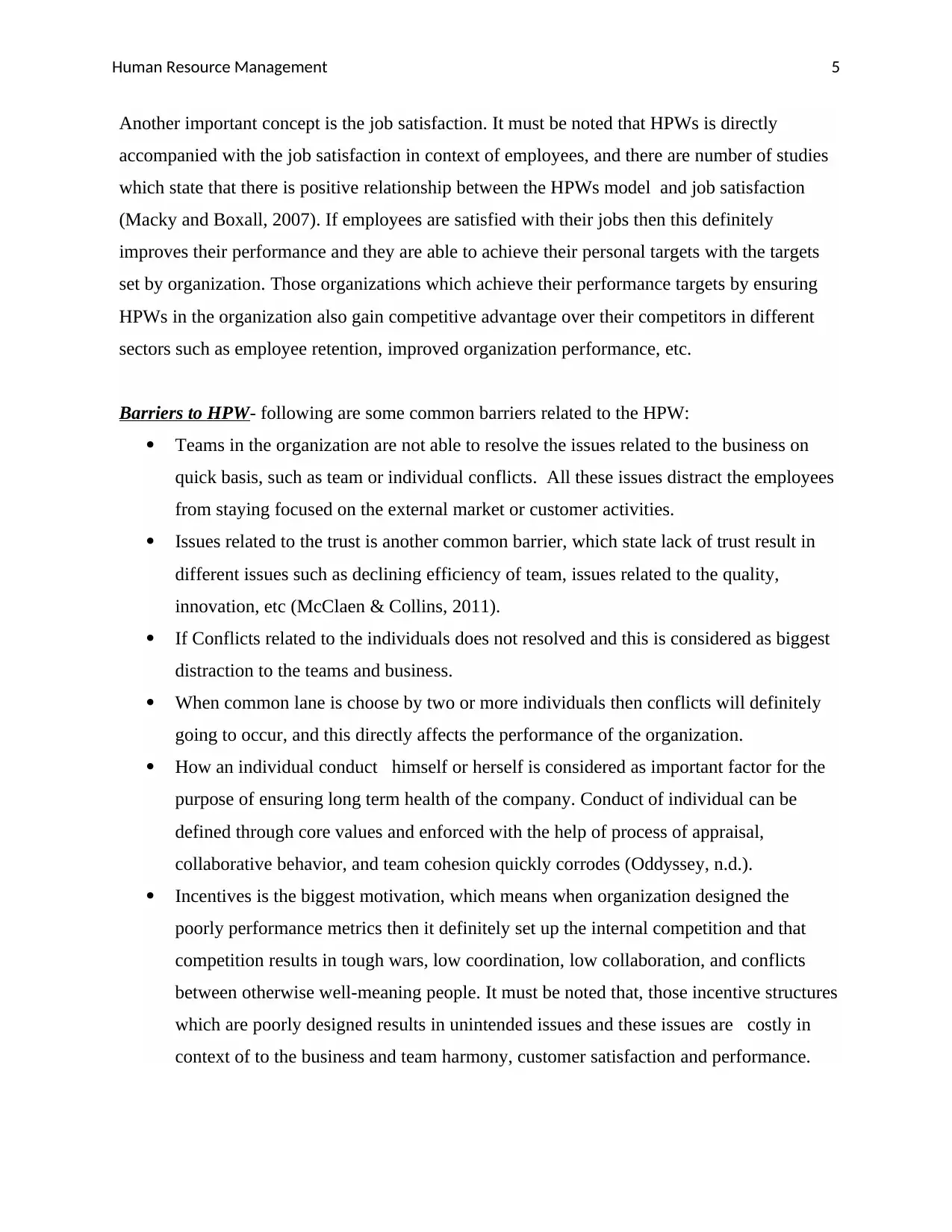
Human Resource Management 5
Another important concept is the job satisfaction. It must be noted that HPWs is directly
accompanied with the job satisfaction in context of employees, and there are number of studies
which state that there is positive relationship between the HPWs model and job satisfaction
(Macky and Boxall, 2007). If employees are satisfied with their jobs then this definitely
improves their performance and they are able to achieve their personal targets with the targets
set by organization. Those organizations which achieve their performance targets by ensuring
HPWs in the organization also gain competitive advantage over their competitors in different
sectors such as employee retention, improved organization performance, etc.
Barriers to HPW- following are some common barriers related to the HPW:
Teams in the organization are not able to resolve the issues related to the business on
quick basis, such as team or individual conflicts. All these issues distract the employees
from staying focused on the external market or customer activities.
Issues related to the trust is another common barrier, which state lack of trust result in
different issues such as declining efficiency of team, issues related to the quality,
innovation, etc (McClaen & Collins, 2011).
If Conflicts related to the individuals does not resolved and this is considered as biggest
distraction to the teams and business.
When common lane is choose by two or more individuals then conflicts will definitely
going to occur, and this directly affects the performance of the organization.
How an individual conduct himself or herself is considered as important factor for the
purpose of ensuring long term health of the company. Conduct of individual can be
defined through core values and enforced with the help of process of appraisal,
collaborative behavior, and team cohesion quickly corrodes (Oddyssey, n.d.).
Incentives is the biggest motivation, which means when organization designed the
poorly performance metrics then it definitely set up the internal competition and that
competition results in tough wars, low coordination, low collaboration, and conflicts
between otherwise well-meaning people. It must be noted that, those incentive structures
which are poorly designed results in unintended issues and these issues are costly in
context of to the business and team harmony, customer satisfaction and performance.
Another important concept is the job satisfaction. It must be noted that HPWs is directly
accompanied with the job satisfaction in context of employees, and there are number of studies
which state that there is positive relationship between the HPWs model and job satisfaction
(Macky and Boxall, 2007). If employees are satisfied with their jobs then this definitely
improves their performance and they are able to achieve their personal targets with the targets
set by organization. Those organizations which achieve their performance targets by ensuring
HPWs in the organization also gain competitive advantage over their competitors in different
sectors such as employee retention, improved organization performance, etc.
Barriers to HPW- following are some common barriers related to the HPW:
Teams in the organization are not able to resolve the issues related to the business on
quick basis, such as team or individual conflicts. All these issues distract the employees
from staying focused on the external market or customer activities.
Issues related to the trust is another common barrier, which state lack of trust result in
different issues such as declining efficiency of team, issues related to the quality,
innovation, etc (McClaen & Collins, 2011).
If Conflicts related to the individuals does not resolved and this is considered as biggest
distraction to the teams and business.
When common lane is choose by two or more individuals then conflicts will definitely
going to occur, and this directly affects the performance of the organization.
How an individual conduct himself or herself is considered as important factor for the
purpose of ensuring long term health of the company. Conduct of individual can be
defined through core values and enforced with the help of process of appraisal,
collaborative behavior, and team cohesion quickly corrodes (Oddyssey, n.d.).
Incentives is the biggest motivation, which means when organization designed the
poorly performance metrics then it definitely set up the internal competition and that
competition results in tough wars, low coordination, low collaboration, and conflicts
between otherwise well-meaning people. It must be noted that, those incentive structures
which are poorly designed results in unintended issues and these issues are costly in
context of to the business and team harmony, customer satisfaction and performance.
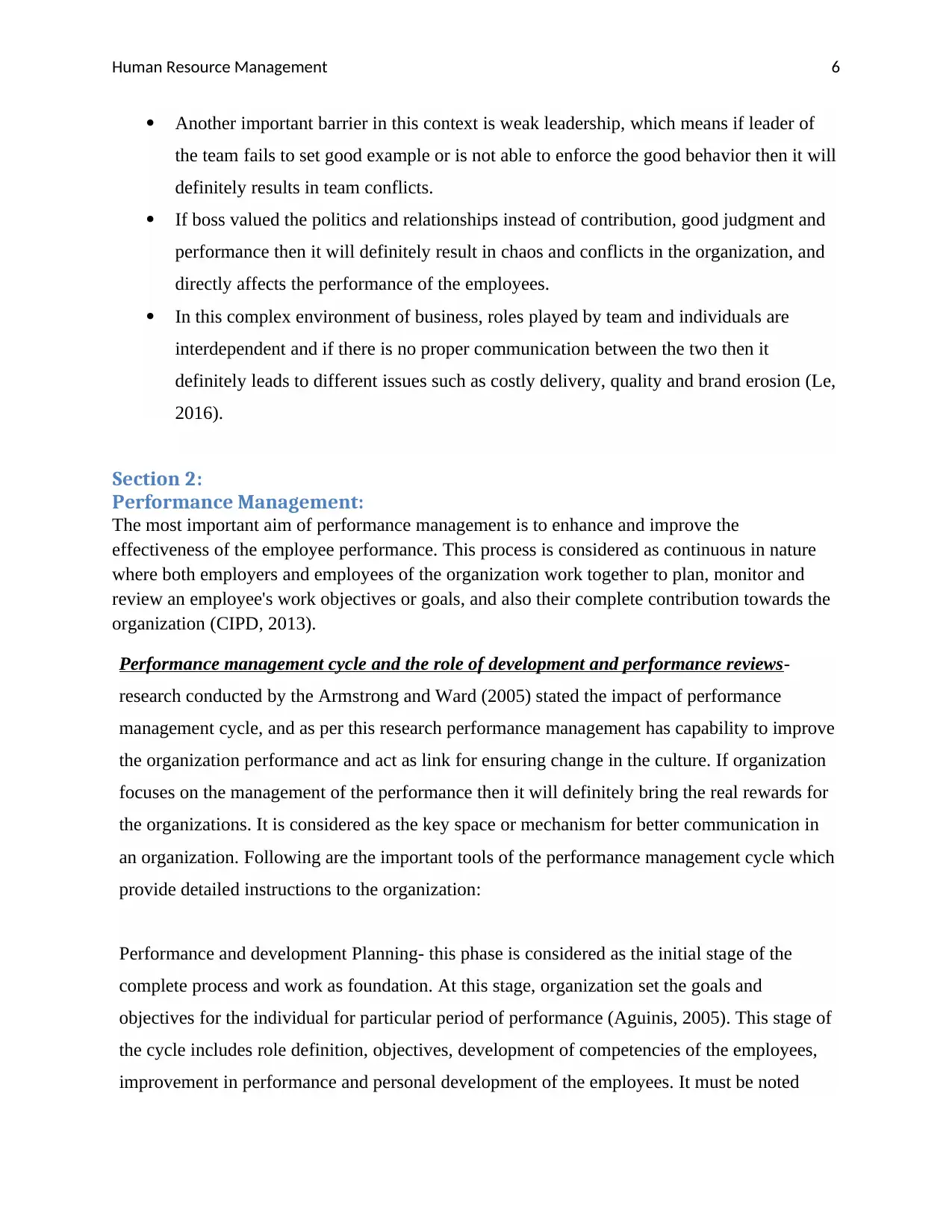
Human Resource Management 6
Another important barrier in this context is weak leadership, which means if leader of
the team fails to set good example or is not able to enforce the good behavior then it will
definitely results in team conflicts.
If boss valued the politics and relationships instead of contribution, good judgment and
performance then it will definitely result in chaos and conflicts in the organization, and
directly affects the performance of the employees.
In this complex environment of business, roles played by team and individuals are
interdependent and if there is no proper communication between the two then it
definitely leads to different issues such as costly delivery, quality and brand erosion (Le,
2016).
Section 2:
Performance Management:
The most important aim of performance management is to enhance and improve the
effectiveness of the employee performance. This process is considered as continuous in nature
where both employers and employees of the organization work together to plan, monitor and
review an employee's work objectives or goals, and also their complete contribution towards the
organization (CIPD, 2013).
Performance management cycle and the role of development and performance reviews-
research conducted by the Armstrong and Ward (2005) stated the impact of performance
management cycle, and as per this research performance management has capability to improve
the organization performance and act as link for ensuring change in the culture. If organization
focuses on the management of the performance then it will definitely bring the real rewards for
the organizations. It is considered as the key space or mechanism for better communication in
an organization. Following are the important tools of the performance management cycle which
provide detailed instructions to the organization:
Performance and development Planning- this phase is considered as the initial stage of the
complete process and work as foundation. At this stage, organization set the goals and
objectives for the individual for particular period of performance (Aguinis, 2005). This stage of
the cycle includes role definition, objectives, development of competencies of the employees,
improvement in performance and personal development of the employees. It must be noted
Another important barrier in this context is weak leadership, which means if leader of
the team fails to set good example or is not able to enforce the good behavior then it will
definitely results in team conflicts.
If boss valued the politics and relationships instead of contribution, good judgment and
performance then it will definitely result in chaos and conflicts in the organization, and
directly affects the performance of the employees.
In this complex environment of business, roles played by team and individuals are
interdependent and if there is no proper communication between the two then it
definitely leads to different issues such as costly delivery, quality and brand erosion (Le,
2016).
Section 2:
Performance Management:
The most important aim of performance management is to enhance and improve the
effectiveness of the employee performance. This process is considered as continuous in nature
where both employers and employees of the organization work together to plan, monitor and
review an employee's work objectives or goals, and also their complete contribution towards the
organization (CIPD, 2013).
Performance management cycle and the role of development and performance reviews-
research conducted by the Armstrong and Ward (2005) stated the impact of performance
management cycle, and as per this research performance management has capability to improve
the organization performance and act as link for ensuring change in the culture. If organization
focuses on the management of the performance then it will definitely bring the real rewards for
the organizations. It is considered as the key space or mechanism for better communication in
an organization. Following are the important tools of the performance management cycle which
provide detailed instructions to the organization:
Performance and development Planning- this phase is considered as the initial stage of the
complete process and work as foundation. At this stage, organization set the goals and
objectives for the individual for particular period of performance (Aguinis, 2005). This stage of
the cycle includes role definition, objectives, development of competencies of the employees,
improvement in performance and personal development of the employees. It must be noted
⊘ This is a preview!⊘
Do you want full access?
Subscribe today to unlock all pages.

Trusted by 1+ million students worldwide
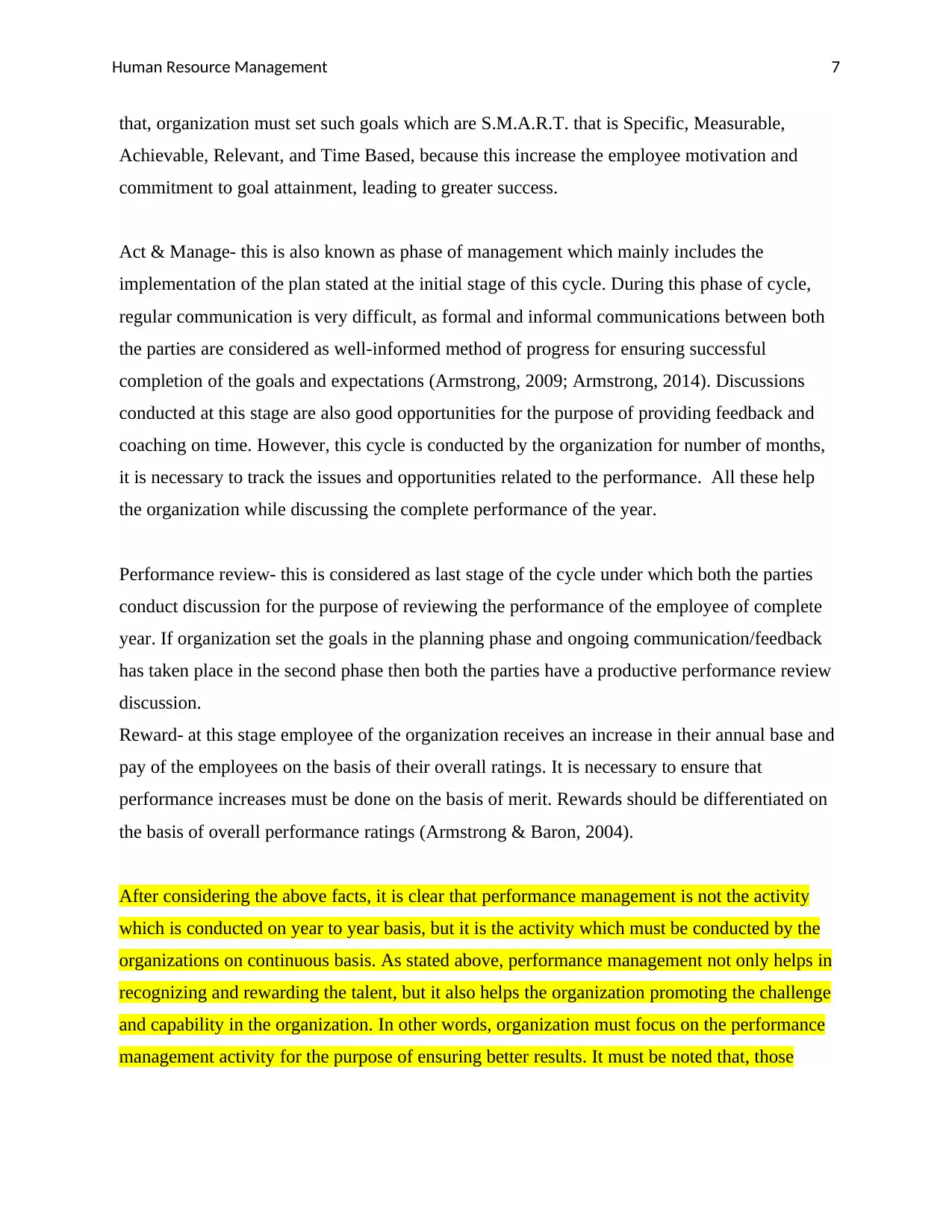
Human Resource Management 7
that, organization must set such goals which are S.M.A.R.T. that is Specific, Measurable,
Achievable, Relevant, and Time Based, because this increase the employee motivation and
commitment to goal attainment, leading to greater success.
Act & Manage- this is also known as phase of management which mainly includes the
implementation of the plan stated at the initial stage of this cycle. During this phase of cycle,
regular communication is very difficult, as formal and informal communications between both
the parties are considered as well-informed method of progress for ensuring successful
completion of the goals and expectations (Armstrong, 2009; Armstrong, 2014). Discussions
conducted at this stage are also good opportunities for the purpose of providing feedback and
coaching on time. However, this cycle is conducted by the organization for number of months,
it is necessary to track the issues and opportunities related to the performance. All these help
the organization while discussing the complete performance of the year.
Performance review- this is considered as last stage of the cycle under which both the parties
conduct discussion for the purpose of reviewing the performance of the employee of complete
year. If organization set the goals in the planning phase and ongoing communication/feedback
has taken place in the second phase then both the parties have a productive performance review
discussion.
Reward- at this stage employee of the organization receives an increase in their annual base and
pay of the employees on the basis of their overall ratings. It is necessary to ensure that
performance increases must be done on the basis of merit. Rewards should be differentiated on
the basis of overall performance ratings (Armstrong & Baron, 2004).
After considering the above facts, it is clear that performance management is not the activity
which is conducted on year to year basis, but it is the activity which must be conducted by the
organizations on continuous basis. As stated above, performance management not only helps in
recognizing and rewarding the talent, but it also helps the organization promoting the challenge
and capability in the organization. In other words, organization must focus on the performance
management activity for the purpose of ensuring better results. It must be noted that, those
that, organization must set such goals which are S.M.A.R.T. that is Specific, Measurable,
Achievable, Relevant, and Time Based, because this increase the employee motivation and
commitment to goal attainment, leading to greater success.
Act & Manage- this is also known as phase of management which mainly includes the
implementation of the plan stated at the initial stage of this cycle. During this phase of cycle,
regular communication is very difficult, as formal and informal communications between both
the parties are considered as well-informed method of progress for ensuring successful
completion of the goals and expectations (Armstrong, 2009; Armstrong, 2014). Discussions
conducted at this stage are also good opportunities for the purpose of providing feedback and
coaching on time. However, this cycle is conducted by the organization for number of months,
it is necessary to track the issues and opportunities related to the performance. All these help
the organization while discussing the complete performance of the year.
Performance review- this is considered as last stage of the cycle under which both the parties
conduct discussion for the purpose of reviewing the performance of the employee of complete
year. If organization set the goals in the planning phase and ongoing communication/feedback
has taken place in the second phase then both the parties have a productive performance review
discussion.
Reward- at this stage employee of the organization receives an increase in their annual base and
pay of the employees on the basis of their overall ratings. It is necessary to ensure that
performance increases must be done on the basis of merit. Rewards should be differentiated on
the basis of overall performance ratings (Armstrong & Baron, 2004).
After considering the above facts, it is clear that performance management is not the activity
which is conducted on year to year basis, but it is the activity which must be conducted by the
organizations on continuous basis. As stated above, performance management not only helps in
recognizing and rewarding the talent, but it also helps the organization promoting the challenge
and capability in the organization. In other words, organization must focus on the performance
management activity for the purpose of ensuring better results. It must be noted that, those
Paraphrase This Document
Need a fresh take? Get an instant paraphrase of this document with our AI Paraphraser
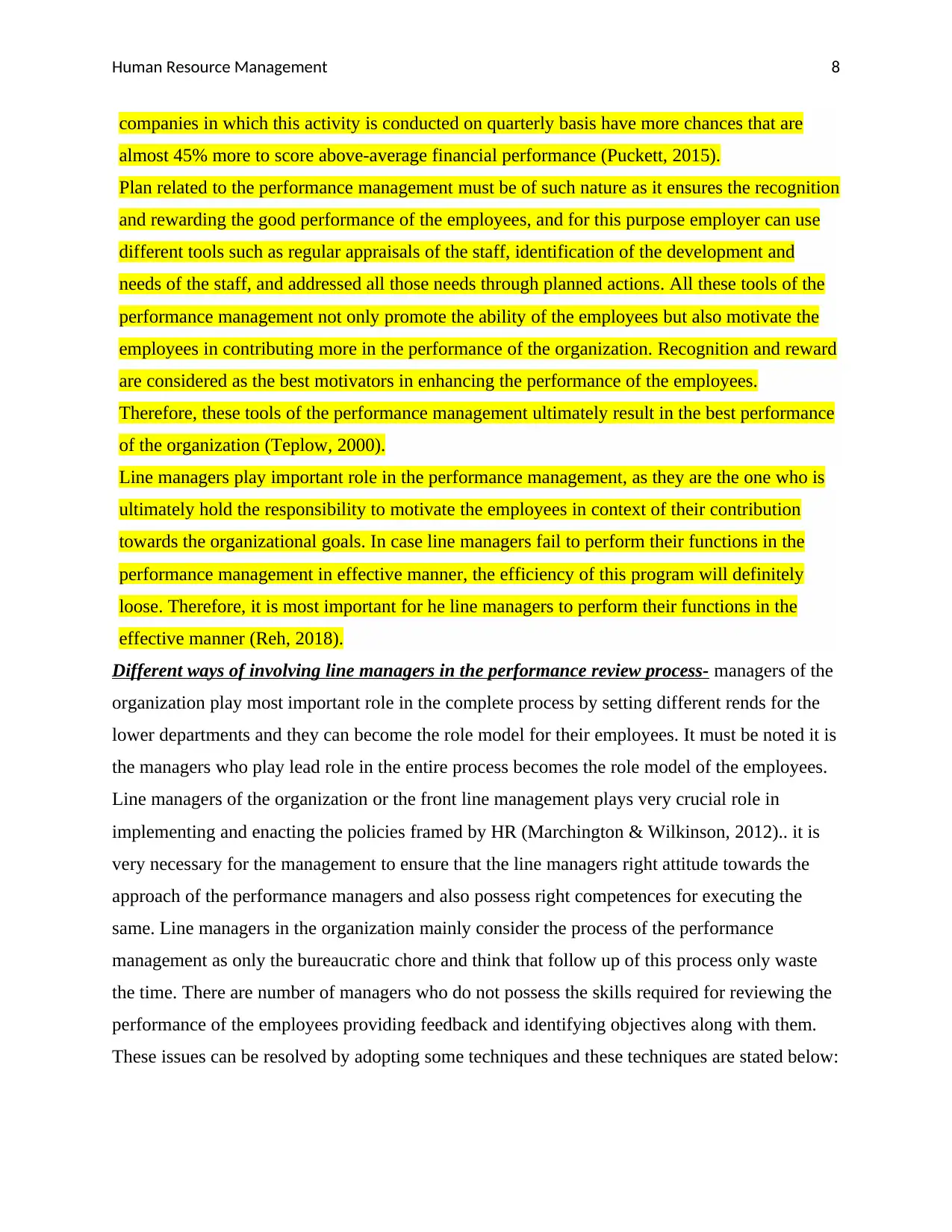
Human Resource Management 8
companies in which this activity is conducted on quarterly basis have more chances that are
almost 45% more to score above-average financial performance (Puckett, 2015).
Plan related to the performance management must be of such nature as it ensures the recognition
and rewarding the good performance of the employees, and for this purpose employer can use
different tools such as regular appraisals of the staff, identification of the development and
needs of the staff, and addressed all those needs through planned actions. All these tools of the
performance management not only promote the ability of the employees but also motivate the
employees in contributing more in the performance of the organization. Recognition and reward
are considered as the best motivators in enhancing the performance of the employees.
Therefore, these tools of the performance management ultimately result in the best performance
of the organization (Teplow, 2000).
Line managers play important role in the performance management, as they are the one who is
ultimately hold the responsibility to motivate the employees in context of their contribution
towards the organizational goals. In case line managers fail to perform their functions in the
performance management in effective manner, the efficiency of this program will definitely
loose. Therefore, it is most important for he line managers to perform their functions in the
effective manner (Reh, 2018).
Different ways of involving line managers in the performance review process- managers of the
organization play most important role in the complete process by setting different rends for the
lower departments and they can become the role model for their employees. It must be noted it is
the managers who play lead role in the entire process becomes the role model of the employees.
Line managers of the organization or the front line management plays very crucial role in
implementing and enacting the policies framed by HR (Marchington & Wilkinson, 2012).. it is
very necessary for the management to ensure that the line managers right attitude towards the
approach of the performance managers and also possess right competences for executing the
same. Line managers in the organization mainly consider the process of the performance
management as only the bureaucratic chore and think that follow up of this process only waste
the time. There are number of managers who do not possess the skills required for reviewing the
performance of the employees providing feedback and identifying objectives along with them.
These issues can be resolved by adopting some techniques and these techniques are stated below:
companies in which this activity is conducted on quarterly basis have more chances that are
almost 45% more to score above-average financial performance (Puckett, 2015).
Plan related to the performance management must be of such nature as it ensures the recognition
and rewarding the good performance of the employees, and for this purpose employer can use
different tools such as regular appraisals of the staff, identification of the development and
needs of the staff, and addressed all those needs through planned actions. All these tools of the
performance management not only promote the ability of the employees but also motivate the
employees in contributing more in the performance of the organization. Recognition and reward
are considered as the best motivators in enhancing the performance of the employees.
Therefore, these tools of the performance management ultimately result in the best performance
of the organization (Teplow, 2000).
Line managers play important role in the performance management, as they are the one who is
ultimately hold the responsibility to motivate the employees in context of their contribution
towards the organizational goals. In case line managers fail to perform their functions in the
performance management in effective manner, the efficiency of this program will definitely
loose. Therefore, it is most important for he line managers to perform their functions in the
effective manner (Reh, 2018).
Different ways of involving line managers in the performance review process- managers of the
organization play most important role in the complete process by setting different rends for the
lower departments and they can become the role model for their employees. It must be noted it is
the managers who play lead role in the entire process becomes the role model of the employees.
Line managers of the organization or the front line management plays very crucial role in
implementing and enacting the policies framed by HR (Marchington & Wilkinson, 2012).. it is
very necessary for the management to ensure that the line managers right attitude towards the
approach of the performance managers and also possess right competences for executing the
same. Line managers in the organization mainly consider the process of the performance
management as only the bureaucratic chore and think that follow up of this process only waste
the time. There are number of managers who do not possess the skills required for reviewing the
performance of the employees providing feedback and identifying objectives along with them.
These issues can be resolved by adopting some techniques and these techniques are stated below:
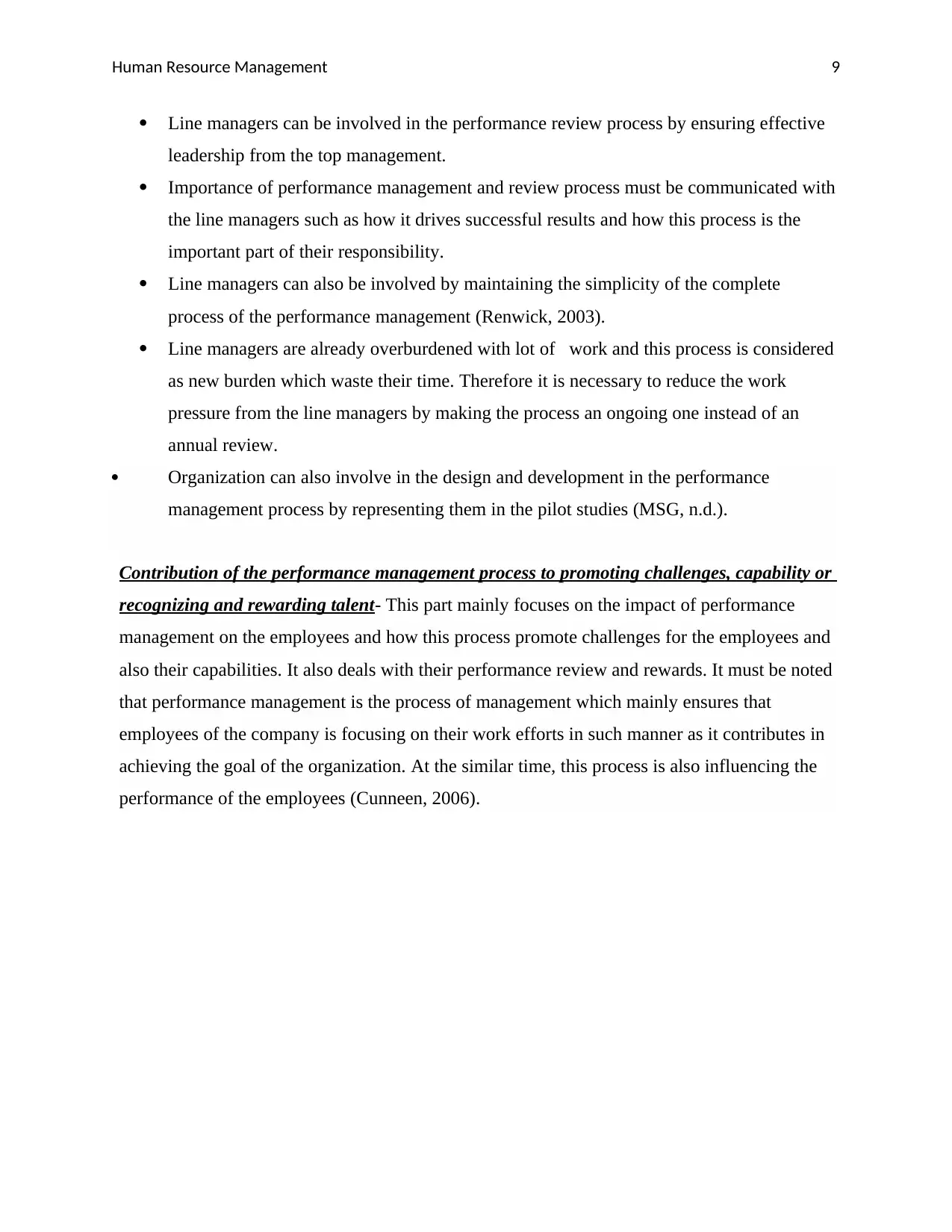
Human Resource Management 9
Line managers can be involved in the performance review process by ensuring effective
leadership from the top management.
Importance of performance management and review process must be communicated with
the line managers such as how it drives successful results and how this process is the
important part of their responsibility.
Line managers can also be involved by maintaining the simplicity of the complete
process of the performance management (Renwick, 2003).
Line managers are already overburdened with lot of work and this process is considered
as new burden which waste their time. Therefore it is necessary to reduce the work
pressure from the line managers by making the process an ongoing one instead of an
annual review.
Organization can also involve in the design and development in the performance
management process by representing them in the pilot studies (MSG, n.d.).
Contribution of the performance management process to promoting challenges, capability or
recognizing and rewarding talent- This part mainly focuses on the impact of performance
management on the employees and how this process promote challenges for the employees and
also their capabilities. It also deals with their performance review and rewards. It must be noted
that performance management is the process of management which mainly ensures that
employees of the company is focusing on their work efforts in such manner as it contributes in
achieving the goal of the organization. At the similar time, this process is also influencing the
performance of the employees (Cunneen, 2006).
Line managers can be involved in the performance review process by ensuring effective
leadership from the top management.
Importance of performance management and review process must be communicated with
the line managers such as how it drives successful results and how this process is the
important part of their responsibility.
Line managers can also be involved by maintaining the simplicity of the complete
process of the performance management (Renwick, 2003).
Line managers are already overburdened with lot of work and this process is considered
as new burden which waste their time. Therefore it is necessary to reduce the work
pressure from the line managers by making the process an ongoing one instead of an
annual review.
Organization can also involve in the design and development in the performance
management process by representing them in the pilot studies (MSG, n.d.).
Contribution of the performance management process to promoting challenges, capability or
recognizing and rewarding talent- This part mainly focuses on the impact of performance
management on the employees and how this process promote challenges for the employees and
also their capabilities. It also deals with their performance review and rewards. It must be noted
that performance management is the process of management which mainly ensures that
employees of the company is focusing on their work efforts in such manner as it contributes in
achieving the goal of the organization. At the similar time, this process is also influencing the
performance of the employees (Cunneen, 2006).
⊘ This is a preview!⊘
Do you want full access?
Subscribe today to unlock all pages.

Trusted by 1+ million students worldwide
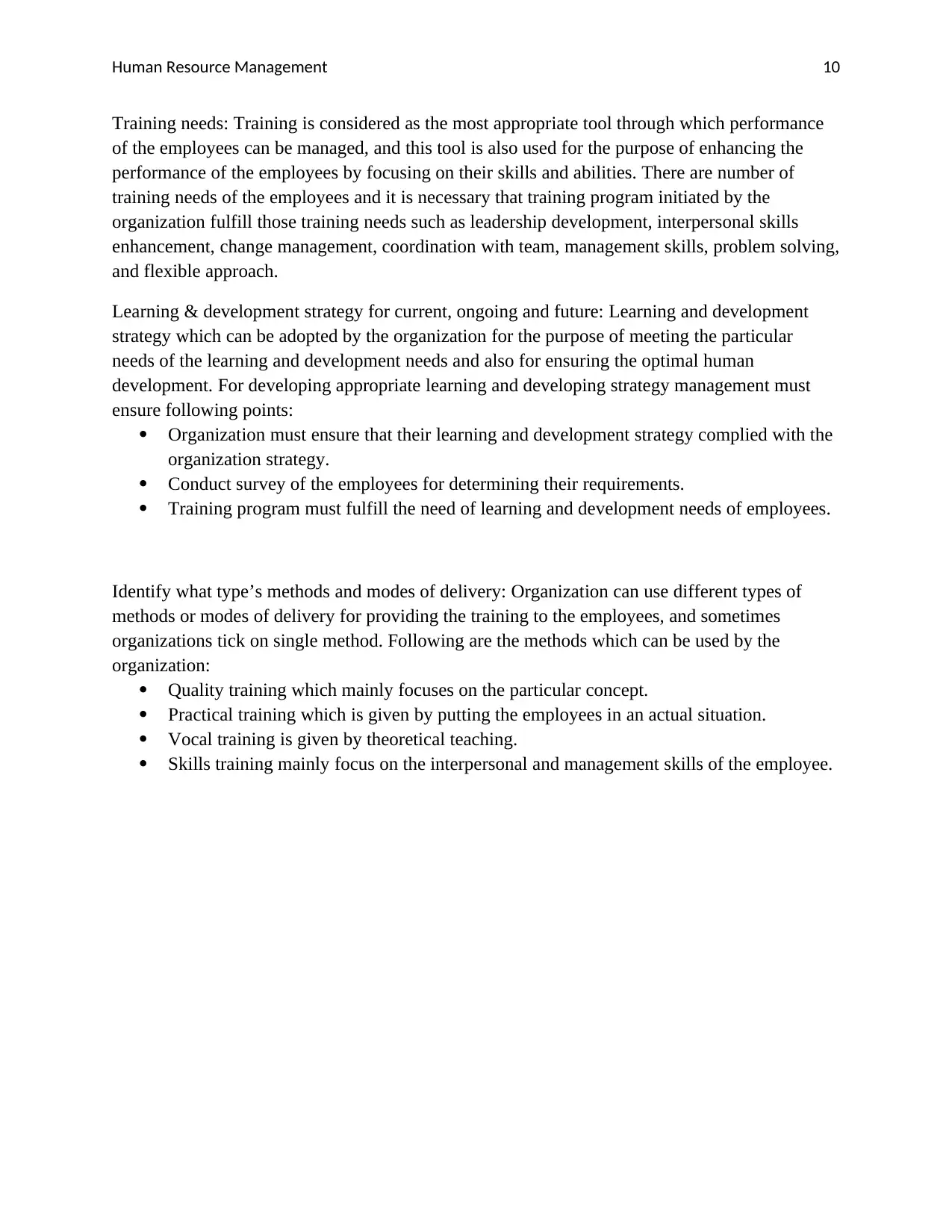
Human Resource Management 10
Training needs: Training is considered as the most appropriate tool through which performance
of the employees can be managed, and this tool is also used for the purpose of enhancing the
performance of the employees by focusing on their skills and abilities. There are number of
training needs of the employees and it is necessary that training program initiated by the
organization fulfill those training needs such as leadership development, interpersonal skills
enhancement, change management, coordination with team, management skills, problem solving,
and flexible approach.
Learning & development strategy for current, ongoing and future: Learning and development
strategy which can be adopted by the organization for the purpose of meeting the particular
needs of the learning and development needs and also for ensuring the optimal human
development. For developing appropriate learning and developing strategy management must
ensure following points:
Organization must ensure that their learning and development strategy complied with the
organization strategy.
Conduct survey of the employees for determining their requirements.
Training program must fulfill the need of learning and development needs of employees.
Identify what type’s methods and modes of delivery: Organization can use different types of
methods or modes of delivery for providing the training to the employees, and sometimes
organizations tick on single method. Following are the methods which can be used by the
organization:
Quality training which mainly focuses on the particular concept.
Practical training which is given by putting the employees in an actual situation.
Vocal training is given by theoretical teaching.
Skills training mainly focus on the interpersonal and management skills of the employee.
Training needs: Training is considered as the most appropriate tool through which performance
of the employees can be managed, and this tool is also used for the purpose of enhancing the
performance of the employees by focusing on their skills and abilities. There are number of
training needs of the employees and it is necessary that training program initiated by the
organization fulfill those training needs such as leadership development, interpersonal skills
enhancement, change management, coordination with team, management skills, problem solving,
and flexible approach.
Learning & development strategy for current, ongoing and future: Learning and development
strategy which can be adopted by the organization for the purpose of meeting the particular
needs of the learning and development needs and also for ensuring the optimal human
development. For developing appropriate learning and developing strategy management must
ensure following points:
Organization must ensure that their learning and development strategy complied with the
organization strategy.
Conduct survey of the employees for determining their requirements.
Training program must fulfill the need of learning and development needs of employees.
Identify what type’s methods and modes of delivery: Organization can use different types of
methods or modes of delivery for providing the training to the employees, and sometimes
organizations tick on single method. Following are the methods which can be used by the
organization:
Quality training which mainly focuses on the particular concept.
Practical training which is given by putting the employees in an actual situation.
Vocal training is given by theoretical teaching.
Skills training mainly focus on the interpersonal and management skills of the employee.
Paraphrase This Document
Need a fresh take? Get an instant paraphrase of this document with our AI Paraphraser
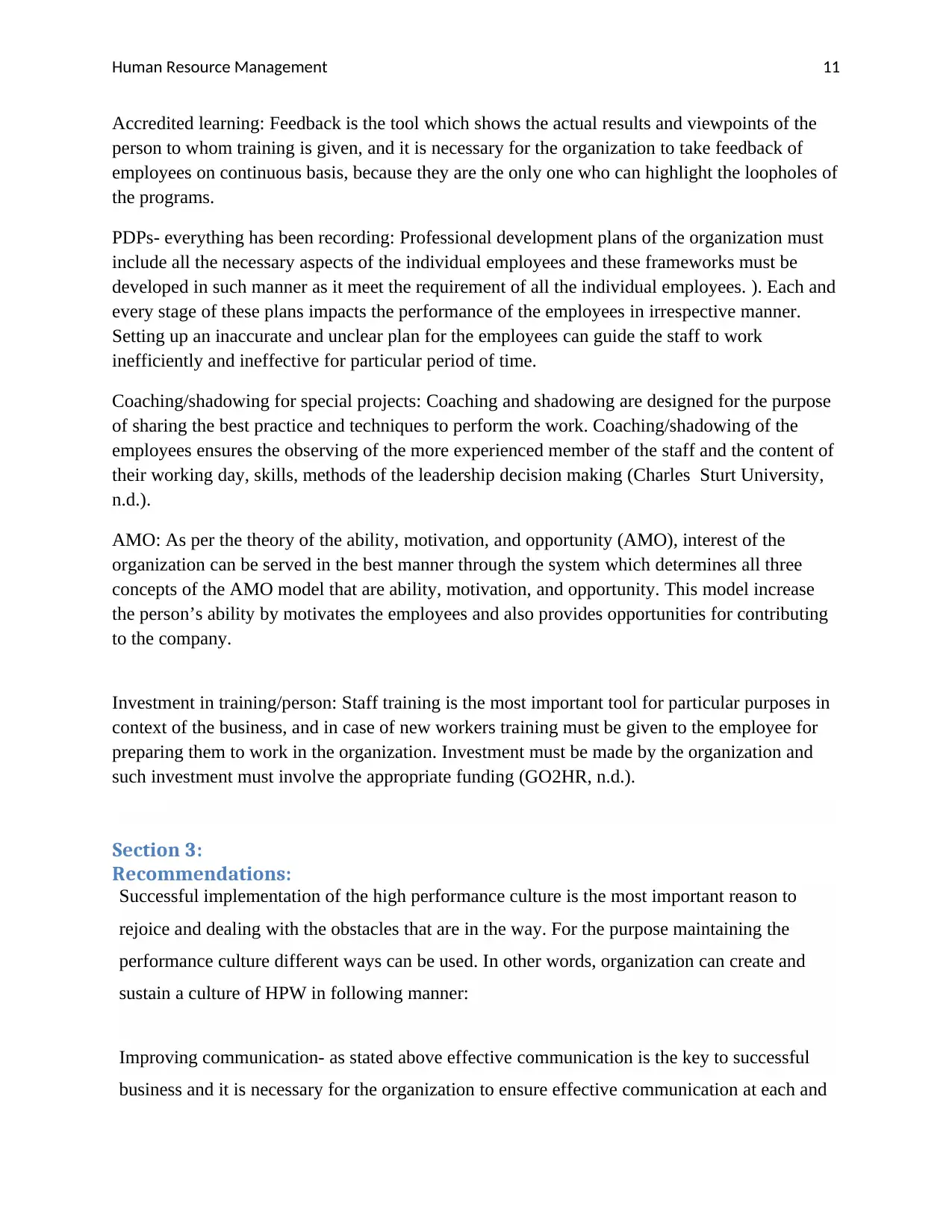
Human Resource Management 11
Accredited learning: Feedback is the tool which shows the actual results and viewpoints of the
person to whom training is given, and it is necessary for the organization to take feedback of
employees on continuous basis, because they are the only one who can highlight the loopholes of
the programs.
PDPs- everything has been recording: Professional development plans of the organization must
include all the necessary aspects of the individual employees and these frameworks must be
developed in such manner as it meet the requirement of all the individual employees. ). Each and
every stage of these plans impacts the performance of the employees in irrespective manner.
Setting up an inaccurate and unclear plan for the employees can guide the staff to work
inefficiently and ineffective for particular period of time.
Coaching/shadowing for special projects: Coaching and shadowing are designed for the purpose
of sharing the best practice and techniques to perform the work. Coaching/shadowing of the
employees ensures the observing of the more experienced member of the staff and the content of
their working day, skills, methods of the leadership decision making (Charles Sturt University,
n.d.).
AMO: As per the theory of the ability, motivation, and opportunity (AMO), interest of the
organization can be served in the best manner through the system which determines all three
concepts of the AMO model that are ability, motivation, and opportunity. This model increase
the person’s ability by motivates the employees and also provides opportunities for contributing
to the company.
Investment in training/person: Staff training is the most important tool for particular purposes in
context of the business, and in case of new workers training must be given to the employee for
preparing them to work in the organization. Investment must be made by the organization and
such investment must involve the appropriate funding (GO2HR, n.d.).
Section 3:
Recommendations:
Successful implementation of the high performance culture is the most important reason to
rejoice and dealing with the obstacles that are in the way. For the purpose maintaining the
performance culture different ways can be used. In other words, organization can create and
sustain a culture of HPW in following manner:
Improving communication- as stated above effective communication is the key to successful
business and it is necessary for the organization to ensure effective communication at each and
Accredited learning: Feedback is the tool which shows the actual results and viewpoints of the
person to whom training is given, and it is necessary for the organization to take feedback of
employees on continuous basis, because they are the only one who can highlight the loopholes of
the programs.
PDPs- everything has been recording: Professional development plans of the organization must
include all the necessary aspects of the individual employees and these frameworks must be
developed in such manner as it meet the requirement of all the individual employees. ). Each and
every stage of these plans impacts the performance of the employees in irrespective manner.
Setting up an inaccurate and unclear plan for the employees can guide the staff to work
inefficiently and ineffective for particular period of time.
Coaching/shadowing for special projects: Coaching and shadowing are designed for the purpose
of sharing the best practice and techniques to perform the work. Coaching/shadowing of the
employees ensures the observing of the more experienced member of the staff and the content of
their working day, skills, methods of the leadership decision making (Charles Sturt University,
n.d.).
AMO: As per the theory of the ability, motivation, and opportunity (AMO), interest of the
organization can be served in the best manner through the system which determines all three
concepts of the AMO model that are ability, motivation, and opportunity. This model increase
the person’s ability by motivates the employees and also provides opportunities for contributing
to the company.
Investment in training/person: Staff training is the most important tool for particular purposes in
context of the business, and in case of new workers training must be given to the employee for
preparing them to work in the organization. Investment must be made by the organization and
such investment must involve the appropriate funding (GO2HR, n.d.).
Section 3:
Recommendations:
Successful implementation of the high performance culture is the most important reason to
rejoice and dealing with the obstacles that are in the way. For the purpose maintaining the
performance culture different ways can be used. In other words, organization can create and
sustain a culture of HPW in following manner:
Improving communication- as stated above effective communication is the key to successful
business and it is necessary for the organization to ensure effective communication at each and
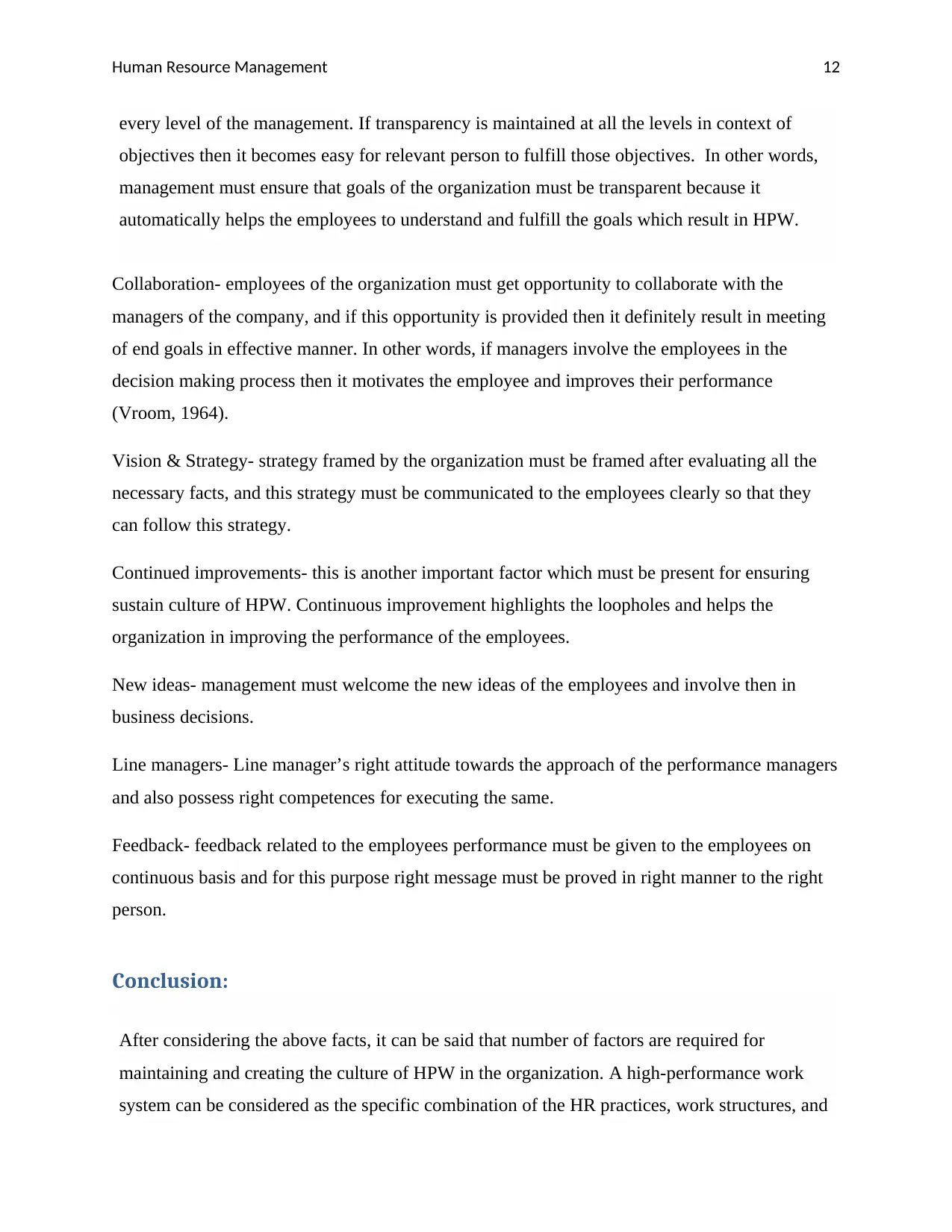
Human Resource Management 12
every level of the management. If transparency is maintained at all the levels in context of
objectives then it becomes easy for relevant person to fulfill those objectives. In other words,
management must ensure that goals of the organization must be transparent because it
automatically helps the employees to understand and fulfill the goals which result in HPW.
Collaboration- employees of the organization must get opportunity to collaborate with the
managers of the company, and if this opportunity is provided then it definitely result in meeting
of end goals in effective manner. In other words, if managers involve the employees in the
decision making process then it motivates the employee and improves their performance
(Vroom, 1964).
Vision & Strategy- strategy framed by the organization must be framed after evaluating all the
necessary facts, and this strategy must be communicated to the employees clearly so that they
can follow this strategy.
Continued improvements- this is another important factor which must be present for ensuring
sustain culture of HPW. Continuous improvement highlights the loopholes and helps the
organization in improving the performance of the employees.
New ideas- management must welcome the new ideas of the employees and involve then in
business decisions.
Line managers- Line manager’s right attitude towards the approach of the performance managers
and also possess right competences for executing the same.
Feedback- feedback related to the employees performance must be given to the employees on
continuous basis and for this purpose right message must be proved in right manner to the right
person.
Conclusion:
After considering the above facts, it can be said that number of factors are required for
maintaining and creating the culture of HPW in the organization. A high-performance work
system can be considered as the specific combination of the HR practices, work structures, and
every level of the management. If transparency is maintained at all the levels in context of
objectives then it becomes easy for relevant person to fulfill those objectives. In other words,
management must ensure that goals of the organization must be transparent because it
automatically helps the employees to understand and fulfill the goals which result in HPW.
Collaboration- employees of the organization must get opportunity to collaborate with the
managers of the company, and if this opportunity is provided then it definitely result in meeting
of end goals in effective manner. In other words, if managers involve the employees in the
decision making process then it motivates the employee and improves their performance
(Vroom, 1964).
Vision & Strategy- strategy framed by the organization must be framed after evaluating all the
necessary facts, and this strategy must be communicated to the employees clearly so that they
can follow this strategy.
Continued improvements- this is another important factor which must be present for ensuring
sustain culture of HPW. Continuous improvement highlights the loopholes and helps the
organization in improving the performance of the employees.
New ideas- management must welcome the new ideas of the employees and involve then in
business decisions.
Line managers- Line manager’s right attitude towards the approach of the performance managers
and also possess right competences for executing the same.
Feedback- feedback related to the employees performance must be given to the employees on
continuous basis and for this purpose right message must be proved in right manner to the right
person.
Conclusion:
After considering the above facts, it can be said that number of factors are required for
maintaining and creating the culture of HPW in the organization. A high-performance work
system can be considered as the specific combination of the HR practices, work structures, and
⊘ This is a preview!⊘
Do you want full access?
Subscribe today to unlock all pages.

Trusted by 1+ million students worldwide
1 out of 16
Related Documents
Your All-in-One AI-Powered Toolkit for Academic Success.
+13062052269
info@desklib.com
Available 24*7 on WhatsApp / Email
![[object Object]](/_next/static/media/star-bottom.7253800d.svg)
Unlock your academic potential
Copyright © 2020–2025 A2Z Services. All Rights Reserved. Developed and managed by ZUCOL.





